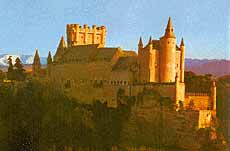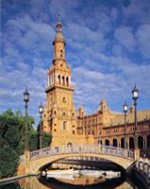|
||||||
|
The Aragonese have a reputation for being straightforward people, and theirs is a harsh stark land of untamed and untouched beauty. Francisco de Goya, born in the village of Fuendetodos, and sardonic film maker Luis Buñuel both grew up here, and their mental toughness and firm principles were quintessentially Aragonese. To the north Aragón is bordered by the Pyrenees and to the south by the Iberian mountains that separate the region from Castile and the orchard land of Valencia. Within Aragón the mountains of El Maestrazgo and Montes Universales create their own awesome beauty. The Ebro, Spain's mightiest river, flows through the center of Aragón past its capital, Zaragoza, forming a vast fertile valley that is among the most productive lands in Spain. |
 |
|
Art lovers will find in Aragón fine examples of the Moorish Mudéjar architectural style, which flourished thanks to the region's tolerant religious policies between the thirteenth and sixteenth centuries. In contrast to the elaborate ornamentation of the Muslim style, there are magnificent Romanesque churches, monasteries, and grand cathedrals like the cathedral of Jaca, in the Pyrenean valleys of Upper Aragón. These owe their existence to the medieval pilgrims en route to Santiago de Compostela, who entered Aragón from France at the mountain pass of Somport. The Way of Saint James brought in its wake the finest artistic styles and medieval villages of unparalled beauty.
|
|
|
Castilla La Manacha History & Culture
It is not easy to categorize Castilla-La Mancha, for it is a region of great variety and complexity. On the one hand, there is the ruddy red earth, the windmills, and simple whitewashed villages of the province of Ciudad Real (which encompasses most of the area commonly called La Mancha). But there are also the strangely sculpted cliffs of Cuenca and Albacete, the hilly woodlands of Guadalajara and the dark mystery and ancient cultures of Toledo.
The city of Toledo is the cultural highlight of Castile-La Mancha, a city that has been over the centuries an essential stronghold for every civilization that settled Spain. Once Roman, it became an opulent Visigothic capital, then an important Moorish center, before becoming the capital of Castile. It was the home of the School of Translators in the thirteenth century, where scholars were instrumental in preserving past knowledge during the Dark Ages, and a unique center of Jewish culture which coexisted in relative peace for over 500 years, with those of the Moslems and the Christians. Toledo was also the home of El Greco. |
|
|
Madrid History & Culture
The region of Madrid divides into two different worlds. Rural Madrid features charming villages like Patones and Chinchón, and first rate sights, such as the majestic El Escorial of Phillip II, Alcalá de Henares, a premiere university town in the sixteenth century, and Aranjuez, where the royal court once summered. Outdoor activities abound, from winter skiing in the high mountains to boating and other water sports in summer. The countryside around the city of Madrid is the escape valve, as it were, for the capital's people, a place where they can relax and enjoy life at a slower pace. |
|
|
The city of Madrid is relatively new, established by Phillip II in the sixteenth century at the geographic center of Spain. In Madrid a cosmopolitan air reigns, and it is a fun-loving city where life is lived to the fullest. Street life is Madrid's trademark, be it in the evocative cobbled streets of Old Madrid or in the sleek new districts. "De Madrid al Cielo"; (from Madrid to Heaven) is the city's well deserved self-congratulatory
|
|
|
Navarra History & Culture
Navarra is an astonishingly varied part of Spain and exceptionally beautiful, especially to the north, where it meets the high Pyrenees, creating a land of soaring peaks, deep valleys, tranquil pastureland, swift-flowing rivers and streams that rush southward, chasmic gorges and thick forests of oak and beech. It is a pastoral landscape of the most luxuriously verdant valleys, where cattle graze and quaint villages of distinctive architecture appear. Navarra gradually levels off to the south in the Ebro Valley, where the climate is appropriate for vineyards, vegetables and wheat. Such is the variety of climates that in a corner of the province known as Las Bárdenas, there is even a mini desert. Navarra shares borders with the Basque Country, Aragón and France and has historical and cultural links with all three. It is a region filled with old towns and villages, with palaces and mansions, cathedrals and monasteries. Clearly marked in Navarra is the great pilgrimage route to Santiago de Compostela. From all over medieval Europe pilgims arrived to Navarra -the first stop on Spanish soil after the Pyrenees were crossed- where their different routes converged to form one tidal wave of humanity making its way to the great shrine of Saint James in Galicia. The route enriched Navarra with Romanesque churches and chapels and with hospitals and inns for those who walked the Way, creating a magnificent religious, cultural and artistic legacy.
|
|

